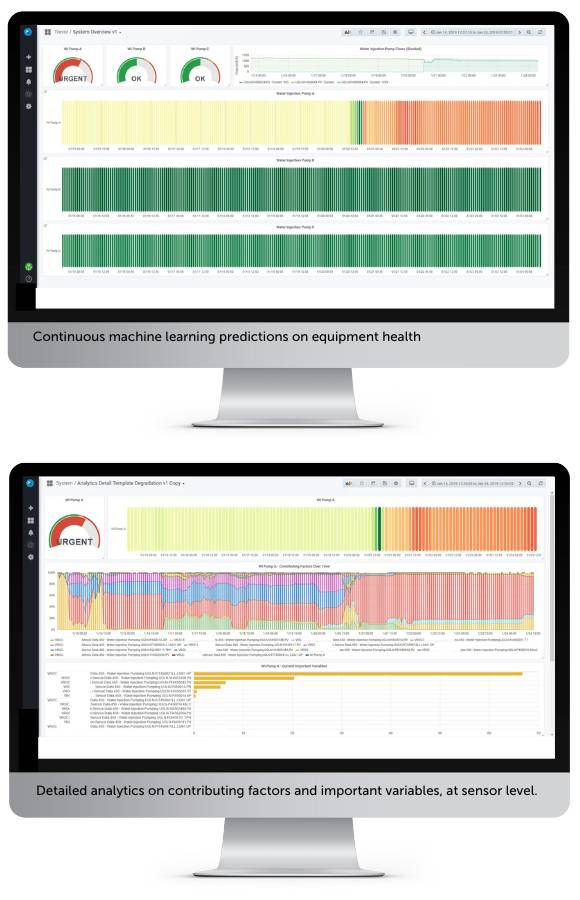Unexpected equipment failures are costly — not just in repairs, but in downtime, lost production, and safety risks. Predictive maintenance uses AI and machine learning to detect early signs of equipment degradation, allowing teams to take action before failures occur.
At VROC, we deliver no-code, AI-powered predictive maintenance that integrates seamlessly with your existing systems. Our models analyse historical and real-time process data to identify anomalies and predict when assets will need attention. Whether you operate in oil & gas, mining, manufacturing, or utilities, our platform helps you reduce downtime, optimise asset life, and maximise return on investment.
With predictive maintenance, maintenance schedules are based on actual asset condition — not fixed intervals or guesswork — enabling a smarter, more cost-effective approach.
Predictive maintenance combines sensor data, process historian information, and AI-driven analytics to forecast equipment health.
The process:
Data collection – IoT sensors, SCADA systems, and plant historians gather time-series data.
AI model training – Machine learning algorithms identify normal operating behaviour and flag anomalies.
Real-time monitoring – Models continuously assess incoming data, generating alerts before failures occur.
Action planning – Maintenance is scheduled only when needed, minimising disruption.

Implementing predictive maintenance delivers measurable business value:
Reduce unplanned downtime – Identify and address issues before they cause production stops.
Lower maintenance costs – Replace parts only when necessary, reducing waste.
Optimise asset lifespan – Maximise the productive life of critical equipment.
Improve safety – Minimise the risk of hazardous failures.
Boost efficiency – Plan maintenance around production schedules.

Reactive maintenance – Fix equipment after it fails. Simple, but can be costly in downtime and emergency repairs.
Preventive maintenance – Schedule maintenance at set intervals to reduce the chance of failure. Effective, but may waste resources replacing healthy components.
Predictive maintenance – Use AI and data to determine when maintenance is truly required. Delivers maximum efficiency and cost savings.

Selecting the right PdM solution is critical to long-term success. Consider:
Integration capability – Can it connect to your current data sources?
Ease of use – Can non-technical teams build models without coding?
Scalability – Will it work across multiple assets and sites?
Accuracy & explainability – Does it provide understandable insights, not just alerts?
ROI tracking – Can you measure the savings and performance improvements?
VROC's platform is built to integrate with your existing equipment and systems, providing maintenance engineers and operators with easy to explain AI insights - Discover OPUS
A successful PdM rollout follows these steps:
Pilot program – Start with a single asset or process to prove value.
Data integration – Connect all relevant sources into one platform.
Model building – Train and deploy AI models using historical and live data.
Implement Maintenance – Use AI alerts and predictions to plan and implement maintenance activities
Scale up – Expand to more equipment and sites (repeating steps 2-4).
Measure & refine – Track ROI and optimise models.
Predictive maintenance uses data and AI to predict when equipment will require service, preventing failures and reducing costs.
Preventive maintenance works on fixed schedules; predictive uses asset condition data to schedule only when necessary.
Industries with high-value assets: oil & gas, mining, manufacturing, utilities, defence and transport.
See case studyThe implementation timeline from purchase order (PO) to full deployment and operation varies by client. The initial setup, including data ingestion and integration, typically takes about three weeks. However, in some cases, clients have achieved full deployment within just two weeks from the start of engagement.
VROC does not place a limit on the number of the models the user can produce for each asset or equipment. The user can create as many models as they need to analyse the asset.
We recommend two years’ worth of historical data to produce the most accurate predictions, however we have had many successful predictions without significant data sets being available.
Alternatively, VROC AI can create digital twin models that learn from real-time data as it flows in. This approach is especially beneficial when clients lack access to historical data or when the available data has low integrity. By continuously processing and learning from incoming data, the digital twin enables VROC AI to refine its predictions over time, increasing accuracy as it becomes more familiar with the asset or process.
Whether you’re launching your first pilot or scaling AI across your enterprise, VROC’s end-to-end platform and expert team can help you unlock data, optimise performance, and accelerate results.
Interested in a demo of one of our data solution products?
DataHUB4.0 is our enterprise data historian solution, OPUS is our Auto AI platform and OASIS is our remote control solution for Smart Cities and Facilities.
Book your demo with our team today!
Complete the form below and we’ll connect you with the right VROC expert to discuss your project. Whether you’re launching a pilot, scaling AI across your enterprise, or integrating complex systems, we’ll help you turn your data into actionable insights—fast, efficiently, and with confidence.
The efficient deployment, continuous retraining of models with live data and monitoring of model accuracy falls under the categorisation called MLOps. As businesses have hundreds and even.
Learn more about DataHUB+, VROC's enterprise data historian and visualization platform. Complete the form to download the product sheet.
Learn how OASIS unifies your systems, streams real-time data, and gives you full control of your smart facility—remotely and efficiently. Complete the form to access the product sheet.
Discover how OPUS, VROC’s no-code Industrial AI platform, turns your operational data into actionable insights. Complete the form below to access the product sheet and learn how you can predict failures, optimise processes, and accelerate AI adoption across your facility.
Interested in reading the technical case studies? Complete the form and our team will be in touch with you.
Subscribe to our newsletter for quarterly VROC updates and industry news.